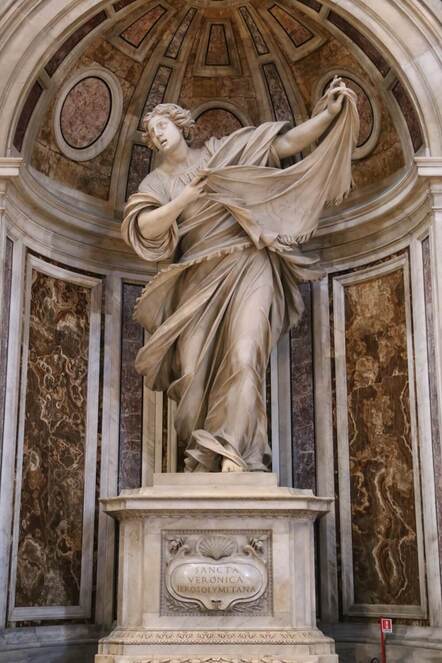|
Where? The Crossing of St. Peter’s Basilica in the Vatican.
When? Carved between 1629 and 1640. Commissioned by? Pope Urban VIII and created under the direction of Gianlorenzo Bernini. What do you see? The statue of Saint Veronica is of colossal size, measuring 5 meters (almost 16.5 feet) tall. The choice of marble colossi for the crossing bears the influence of the Pope, as the colossus was a sculptural type considered one of the most impressive accomplishments of the ancients and was also closely associated with Michelangelo. In fact, the earliest records related to the effort to obtain marble for the four crossing statues indicate that it was initially hoped that each statue would be carved from a single colossal block, similar to Michelangelo’s David. However, this was not the case as each figure was made from multiple blocks. Nevertheless, Saint Veronica is only centimeters short of Michelangelo’s David, though one might not suspect that due to the disorienting scale of St. Peter’s Basilica. At five meters high, Mochi’s Saint Veronica is half a meter higher than the three other colossi, despite the fact that it is the only figure that leans forward rather than standing fully upright. Also, unlike the other three statues, Saint Veronica is not made from two primary blocks, but, as Mochi is quoted, from “three great blocks, put together in a most difficult way in which the joins are never seen again.” Mochi’s seamless and ingenious construction from three separate blocks made the dramatic forward lean of the figure possible, speaking to the balance of technical and formal invention in Baroque sculpture. At the left rear of the figure, Mochi carved his signature, indicating through this symbolic counterweight his literal and figurative balancing act in Saint Veronica. Backstory: In 1624, Bernini was at work on the Baldacchino marking the high altar of St. Peter’s, and over the next several years, ideas for housing the basilica’s most prized relics in the crossing piers evolved through discussions with the Pope. The need for altars associated with the relics was strongly felt for liturgical and devotional purposes. While this plan for honoring the relics through sculpted altars remained unchanged, a recognition that the new basilica required a solution more appropriate to the grandeur of the crossing led to the introduction of a new element: colossal marble sculptures.
0 Comments
|
Categories
All
|
- Home
- Blog
-
Museums
- Alte Pinakothek
- Art Institute of Chicago
- Baltimore Museum of Art
- Barber Institute of Fine Arts
- Bargello
- Barnes Foundation
- British Museum
- Church of Sant’Anastasia
- Cleveland Museum of Art
- Courtauld Institute of Art
- Detroit Institute of Arts
- Frans Hals Museum
- Galleria Borghese
- Gallerie dell'Accademia
- Getty Museum
- Guggenheim
- Hermitage Museum
- Kunsthistorisches Museum
- Kunstmuseum Basel
- Legion of Honor Museum
- Louvre
- Mauritshuis
- Metropolitan Museum of Art
- Musee d’Orsay
- Museum of Fine Arts in Boston
- Museum of Modern Art
- National Gallery in London
- National Gallery of Art
- National Museum in Poznań
- Norton Simon Museum
- Ny Carlsberg Glyptotek
- Palace of Versailles
- Palazzo Pitti
- Palazzo Vecchio
- Petit Palais
- Philadelphia Museum of Art
- Prado
- Pushkin Museum
- Ravenna Art Museum
- Rijksmuseum
- San Diego Museum of Art
- Santa Maria delle Grazie
- St. Peter's Basilica
- Städel Museum
- Statens Museum for Kunst
- Tate Britain
- Tate Modern
- Timken Museum of Art
- Uffizi
- Vatican Museums
- Wallace Collection
-
Artists
- Altdorfer
- Anguissola
- Berlin Painter
- Bosch
- Botticelli
- Boucher
- Bronzino
- Bruegel the Elder
- Brunelleschi
- Cabanel
- Caillebotte
- Canova
- Caravaggio
- Carpeaux
- Cezanne
- Cimabue
- David
- Degas
- Delacroix
- De Maria
- Donatello
- El Greco
- Fontana
- Fra Angelico
- Fragonard
- Gauguin
- Gentileschi
- Gericault
- Gonzalez-Torres
- Goya
- Hals
- Hogarth
- Hokusai
- Ingres
- Leonardo da Vinci
- Lippi, Filippo
- Longhi, Barbara
- Lorrain
- Makovsky
- Manet
- Massys
- Matisse
- Merian
- Michelangelo
- Mochi
- Modigliani
- Monet
- Panini
- Parmigianino
- Perugino
- Picasso
- Pisanello
- Raphael
- Rembrandt
- Renoir
- Reynolds
- Rivera
- Rodin
- Rubens
- Scultori
- Seurat
- Steen
- Tintoretto
- Titian
- Toulouse-Lautrec
- Turner
- Uccello
- Van der Weyden
- Van Dyck
- Van Eyck
- Van Gogh
- Van Hemessen
- Vasari
- Velazquez
- Vermeer
- Veronese
- Vigée Le Brun
-
Locations
- Books
- About Us

